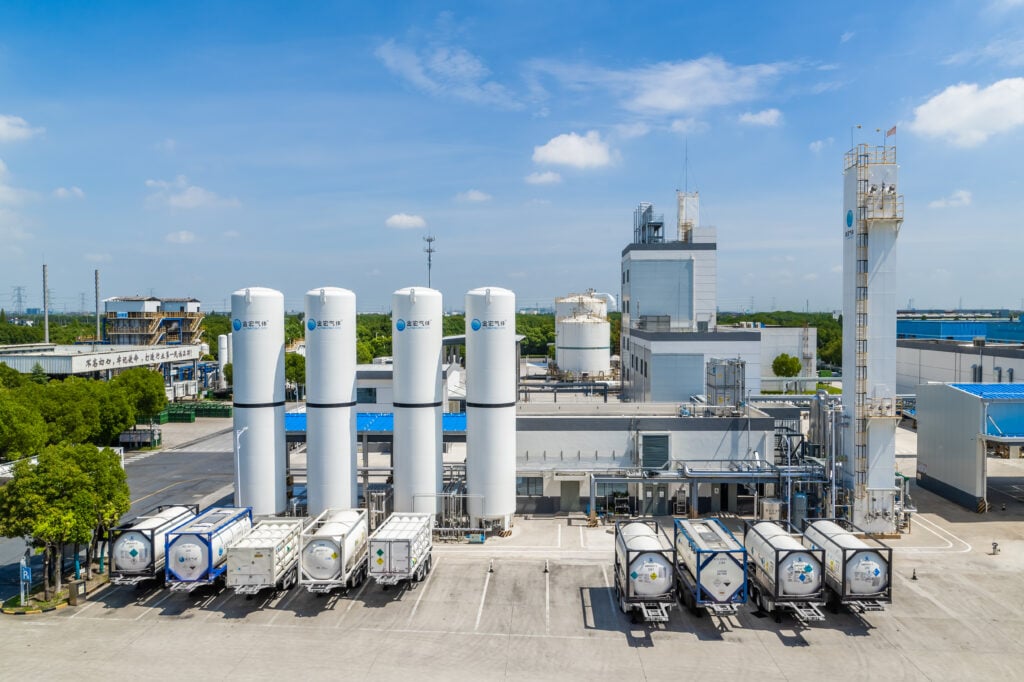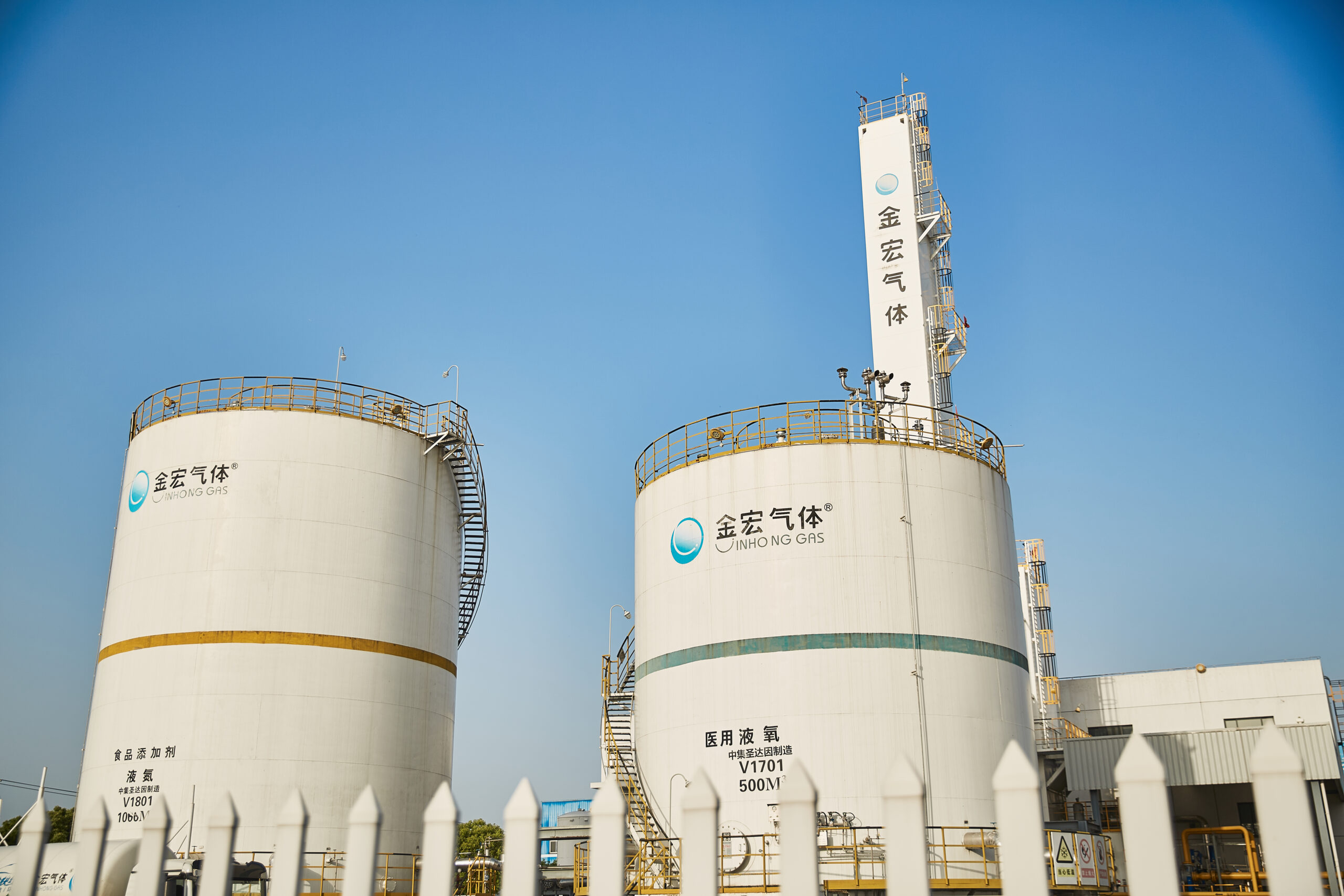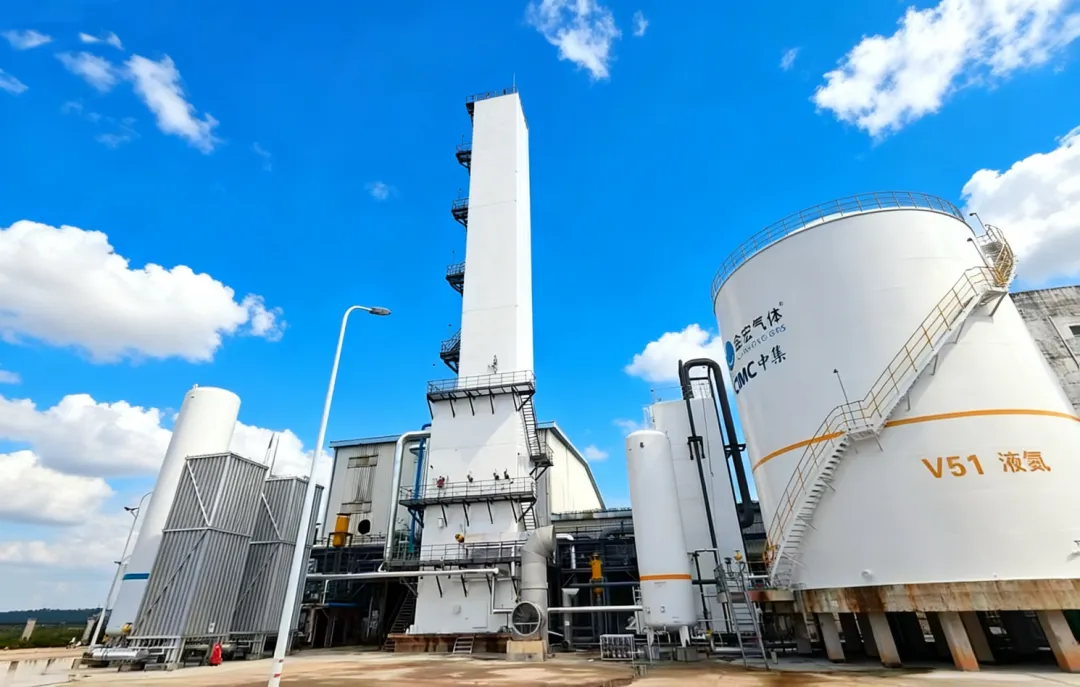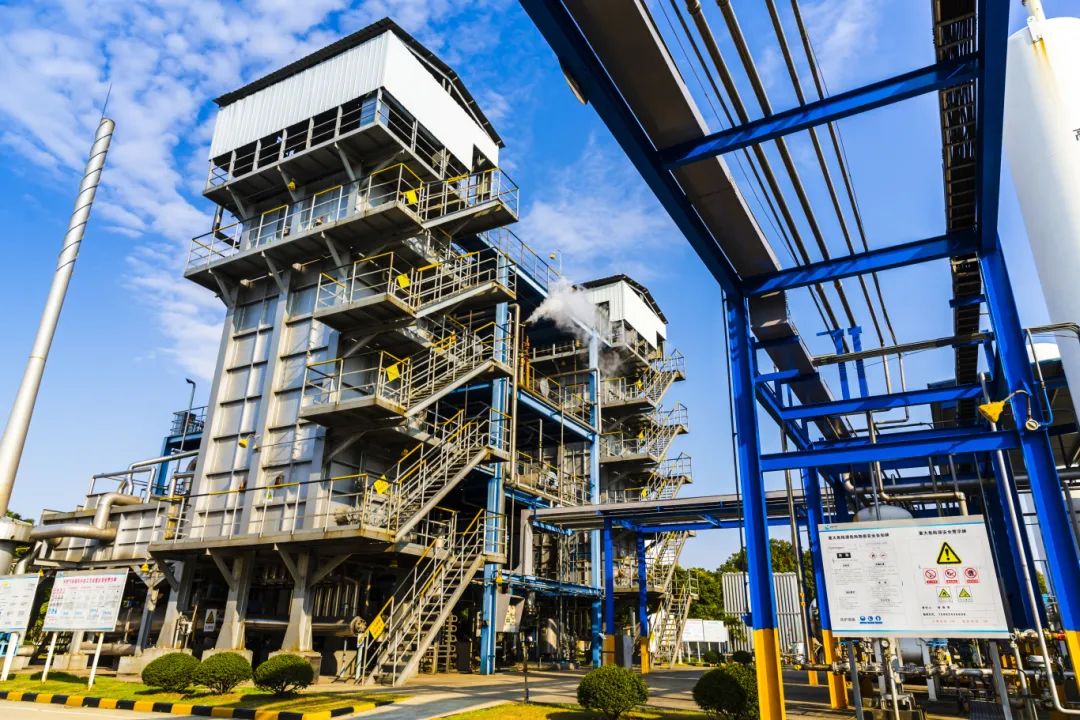Do you know what sulfur hexafluoride is?
Sulfur hexafluoride is an inorganic compound with the chemical formula SF₆. It is a colorless, odorless, non-toxic, non-flammable gas at room temperature and pressure. Its density is about 5 times that of air, and it has good insulation and arc extinguishing properties. The chemical properties of sulfur hexafluoride are very stable. Under normal circumstances, it will not react chemically with other substances. It has high thermal stability and chemical inertness, and is not easily oxidized, reduced or hydrolyzed.

Sulfur hexafluoride is usually produced by the direct chemical reaction of sulfur and fluorine. During the reaction, sulfur burns in excess fluorine gas to produce sulfur hexafluoride.
Core characteristics
| Characteristics | Value/performance | Industrial value |
| Density | 6.17 kg/m³ (5 times that of air) | Deposits in low places after leakage |
| Dielectric strength | 35 kV/cm (25°C, 0.1MPa) | Insulation volume is reduced by 90% under the same pressure |
| Chemical stability | No decomposition below 500°C | Equipment life is up to 30 years |
| Greenhouse effect | GWP=23,500 (CO₂=1) | 1kg SF₆=24 man-years of carbon emissions |
https://en.wikipedia.org/wiki/Sulfur_hexafluoride
Sulfur hexafluoride is also a greenhouse gas with a high greenhouse effect potential (GWP) and a lifespan in the atmosphere of about 3,200 years. Although the content of sulfur hexafluoride in the atmosphere is low, due to its potential impact on global climate change, the international community has begun to pay attention and take measures to limit its emissions.
- 1 ton of SF₆ = 23,500 tons of CO₂ (on a century scale), with annual global emissions of about 8,000 tons (equivalent to annual emissions from 190 million cars).
- Atmospheric life: 3,200 years without decomposition, with significant cumulative effects.
Global Control Measures
| Global Control MeasuresRegion | Policy | Key Requirements |
| EU | F-gas Regulation | Most new SF₆ equipment will be banned in 2030 |
| USA | EPA Leakage Standard | Annual leakage rate <1%, mandatory recycling |
| China | “Grid Greenhouse Gas Accounting Guidelines” | Require SF₆ recycling rate ≥ 90%, pilot g³ replacement technology |
From high-voltage power grids to cutting-edge technology
Sulfur hexafluoride (SF₆) has become an irreplaceable functional gas in modern industry due to its excellent insulation, arc extinguishing ability and chemical stability.
With the continuous advancement and development of technology in various industries, the performance requirements for sulfur hexafluoride are becoming increasingly diversified, and its scope of application is also continuously expanding.
- Power industry.
The power industry is highly dependent on SF₆: 80% of SF₆ is used in gas-insulated equipment (GIS) worldwide, and China’s UHV projects consume more than 5,000 tons annually.
Gas-insulated switchgear
Technical advantages: The area occupied is only 10% of that of traditional substations (such as the 500kV underground GIS station in Jing’an, Shanghai), and the failure rate is reduced to 0.1 times/station/year
Typical configuration: Rated voltage 72.5kV~1100kV, SF₆ filling pressure: 0.4~0.6 MPa
—As an insulating medium, in power equipment, insulation performance is one of the key factors to ensure the safe and stable operation of equipment. The excellent insulation performance of sulfur hexafluoride makes it a widely used insulating medium in high-voltage electrical equipment such as ultra-high voltage and ultra-high voltage circuit breakers, large-capacity transformers, high-voltage cables, gas-insulated switchgear (GIS) and ring network power supply units.
The insulation strength is about 2.5 times that of air, which can effectively improve the insulation performance of the equipment and reduce the risk of arc discharge inside the equipment, thereby greatly improving the reliability of power equipment operation.
For example, in the construction of urban power grids, space resources are often relatively tight. Electrical equipment using sulfur hexafluoride insulation can better adapt to this environment and meet the needs of urban power supply.
—As an arc extinguishing medium, an arc will be generated during the operation of the power system when a circuit fails or a switch is operated. If the arc cannot be extinguished in time, it may cause serious accidents such as equipment damage or even fire. As a highly electronegative gas, it has excellent arc extinguishing ability, which is about 100 times that of air.
For example, in the protection device of high-voltage transmission lines, sulfur hexafluoride circuit breakers can cut off fault currents in a very short time to ensure the normal power supply of the power system.
Arc extinguishing performance comparison:
| Dielectric type | Interrupting current (kA) | Electrical life (times) |
| SF₆ | 63 | 10,000 |
| Vacuum | 40 | 30,000 |
| Air | 31 | 1,000 |
- Electronic semiconductor industry
Plasma Etching
In the field of microelectronics such as computer chips and LCD screens, the manufacturing process has extremely high requirements for precision.
By accurately controlling the flow, pressure and plasma parameters of sulfur hexafluoride during the etching process, the etching depth and precision can be accurately controlled to meet the needs of the continuous miniaturization and high performance of microelectronic devices. For example, after the photolithography process of chip manufacturing, etching with sulfur hexafluoride can accurately transfer the photolithographic pattern to the semiconductor material, laying the foundation for the high-performance operation of the chip.
Process Requirements:
Purity ≥ 99.999% (electronic grade)
Particles < 0.1μm
Cleaners
During semiconductor processing, maintaining the cleanliness of equipment and chip surfaces is crucial to ensuring chip quality and performance.
sulfur hexafluoride can be used to clean impurities and residues on the surface of semiconductor processing equipment and chips. Its chemical stability and good volatility prevent it from causing secondary pollution to the equipment and chip surfaces during the cleaning process, and it can effectively remove various organic and inorganic impurities. For example, between the various processes of chip manufacturing, using sulfur hexafluoride to clean equipment and chips can ensure the smooth progress of subsequent processes and improve the yield rate of chips.
- Medical and scientific research (5% dosage)
As an ultrasonic contrast agent, sulfur hexafluoride microbubbles play an important role in medical ultrasound imaging diagnosis.
Take SonoVue as an example. Its main ingredient is sulfur hexafluoride microbubbles. When SonoVue is injected into the human body through intravenous injection, the microbubbles will be distributed throughout the body through blood circulation. In echocardiography, it can enhance the opacity of the heart chambers and make the left ventricular endocardial edge line more clearly depicted, which helps doctors more accurately evaluate the structure and function of the heart and diagnose cardiovascular diseases.
| Application scenarios | Technical principles | Cases |
| Retinal surgery | SF₆ bubble fixation of retina | Beijing Tongren Hospital annual consumption 2000L |
| Particle accelerator | Beam pipe insulation | CERN Large Hadron Collider in Europe |
| Acoustic research | High sound speed environment simulation (1470 m/s) | Submarine sonar test |
- Metallurgical Industry
During the smelting and casting process of nonferrous metals such as magnesium alloys and magnesium-aluminum alloys, metals are prone to oxidation reactions with oxygen in the air at high temperatures, affecting the quality and purity of the metals.
For example, in the smelting process of magnesium alloy, introducing Sulfur hexafluoride protective gas into the furnace can significantly reduce the burning loss of magnesium and improve the quality and yield rate of magnesium alloy. This is of great significance for improving the production quality of non-ferrous metals and reducing production costs.
Magnesium alloy casting: SF₆+CO₂ mixed gas prevents molten magnesium from oxidizing
- Other fields
As a tracer, it has the advantages of good chemical stability, not easy to adsorb and decompose, and long tracing distance, so it is an ideal tracer for air pollution measurement. When studying atmospheric circulation, pollutant diffusion and other issues, a certain amount of Sulfur hexafluoride is released into the atmosphere. By monitoring the concentration changes of Sulfur hexafluoride at different locations, the flow direction and speed of the atmosphere, as well as the diffusion law of pollutants in the atmosphere, can be understood.
Tracer gas: Detect underground pipeline leaks (sensitivity 10⁻⁶)
- Comprehensive comparison of environment and cost
| Dimension | SF₆ advantages | SF₆ disadvantages |
| Insulation performance | Better than air, nitrogen, and vacuum | Highly sealed equipment is required, and the cost is high |
| Environmental protection | No ozone depletion effect (ODP=0) | Extremely strong greenhouse effect (high GWP) |
| Operation and maintenance cost | Long equipment life and long maintenance cycle | High recycling and purification costs, requiring professional treatment |
| Application scenarios | High irreplaceability of high-voltage power equipment | Gradually replaced in the industrial/medical fields |
Comparison of the advantages and differences of sulfur hexafluoride gas applications
Domestic price: Affected by the cost of raw materials and environmental protection policies, it has increased slightly. It is expected to stabilize in the range of 36,000-38,000 yuan/ton in 2025, which is about 36-38 yuan/kg after conversion. On some chemical websites, sulfur hexafluoride with a purity of 99.999% is packaged in 8L/10L/40L products. Some manufacturers sell their products by bottle, and the price ranges from a few hundred yuan to several thousand yuan.
Foreign price: The price of sulfur hexafluoride abroad is denominated in US dollars. The price in North American markets such as the United States and Canada is relatively stable. There will be fluctuations due to transportation and logistics issues. There are regional price differences in areas such as California and Massachusetts that implement stricter sulfur hexafluoride emission regulations. The price of the European market soared sharply in the second half of 2024, as the EU announced that it would gradually phase out switchgear containing sulfur hexafluoride from 2026, which led to increased market uncertainty. Power transmission companies began strategic reserves, which greatly tightened the supply of traditional sulfur hexafluoride and intensified price fluctuations.
Price fluctuations are affected by the following factors:
Policy: Domestic and foreign environmental protection policies and related regulations have a great impact on the price of sulfur hexafluoride. The strengthening of environmental protection supervision in China requires restrictions on production, which affects market supply and prices. In foreign countries, such as the EU’s plan to phase out switchgear containing sulfur hexafluoride, it directly leads to price fluctuations in the European market.
Supply and demand: The major power equipment manufacturers and electronic companies in East China and South China are concentrated in China, and the demand for sulfur hexafluoride is large. If the supply is insufficient, the price is easy to rise. The supply and demand situation in different regions abroad is also uneven. Southeast Asian countries rely on imports and have limited domestic production, so the price is significantly affected by the supply of the international market.
Production cost: The production of sulfur hexafluoride requires a certain amount of raw materials and energy input. Rising raw material prices or energy costs can drive up product prices.
Domestic market
Demand scale: China is the world’s largest SF₆ consumer, accounting for more than 60%. The power industry (GIS switches, circuit breakers) accounts for more than 85% of demand. Metal processing and semiconductors account for 10%~15%.
International market
Demand trend: Demand in Europe, the United States and Japan is declining year by year (annual decline of 3%~5%), restricted by environmental protection policies (such as EU F-Gas regulations). Demand in emerging markets India and Southeast Asia is growing (annual growth rate of 5%~8%), but the base is small.
How to buy sulfur difluoride gas?
As the world’s leading SF₆ gas supplier, we provide: 99.999% high-purity SF₆ (in compliance with IEC 60376 standard), full life cycle services, and cost optimization (large quantities enjoy tiered discounts) for the power, semiconductor, medical and other industries.
If you have some technical needs such as GIS equipment filling and recycling, electronic grade SF₆ (etching/cleaning), retinal surgery gas, etc., you can directly send us an email or call us, and privately message our platform account. We also provide value-added services, such as: free testing, GIS equipment physical examination, recycling and replacement, etc.
- Comparison of our product advantages
| Indicators | Our solutions | Imported brands (such as Linde) | Domestic regular suppliers |
| Purity stability | ±0.001% (electronic grade) | ±0.0005% | ±0.01% |
| Delivery cycle | 72 hours (24 hours for urgent orders) | 4-6 weeks (sea shipping) | 1-2 weeks |
| Environmental protection | Free recycling equipment rental | Additional charge (¥50,000/unit) | No recycling service |
FAQ
- Is sulfur hexafluoride harmful to the human body?
Sulfur hexafluoride itself is non-toxic, but in a high concentration environment, it will cause harm to the human body due to lack of oxygen.
- How to use sulfur hexafluoride safely?
In places where sulfur hexafluoride is used, good ventilation conditions should be maintained, gas leakage monitoring devices should be equipped, and the concentration of sulfur hexafluoride in the air should be regularly tested. Operators should wear appropriate protective equipment, such as gas masks, etc.
- How is sulfur hexafluoride produced?
Sulfur hexafluoride is usually produced by the direct reaction of fluorine and sulfur. In the specific production process, sulfur is burned in fluorine gas, and a high-purity sulfur hexafluoride product is obtained after a series of reactions and refining processes.
- What industries is SF₆ mainly used in?
Sulfur difluoride is mainly used in the power industry (more than 90%), industry, medical care, etc.
- How to reduce the risk of SF₆ leakage?
High-sealing equipment (such as GIS) can be used, and secondly, an online monitoring system can be installed to detect leaks in real time and strictly recycle the gas in scrapped equipment (the EU requires a recovery rate of >90%).



